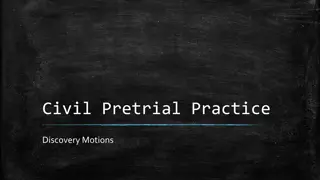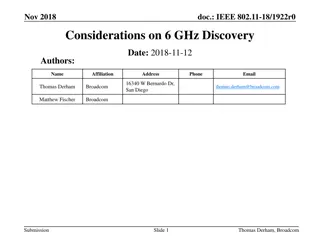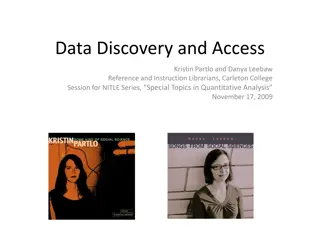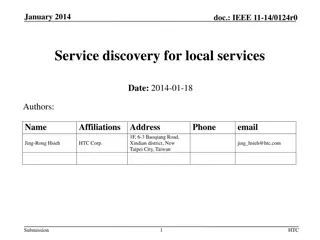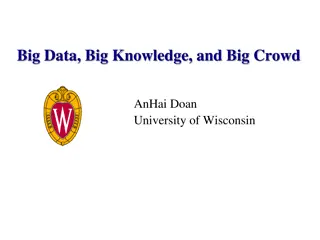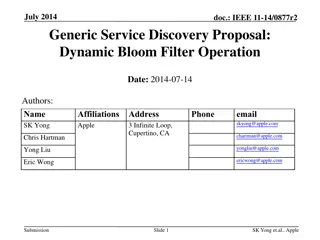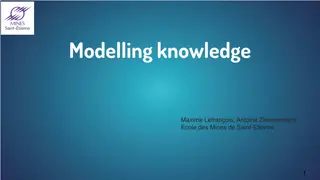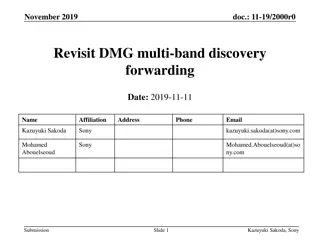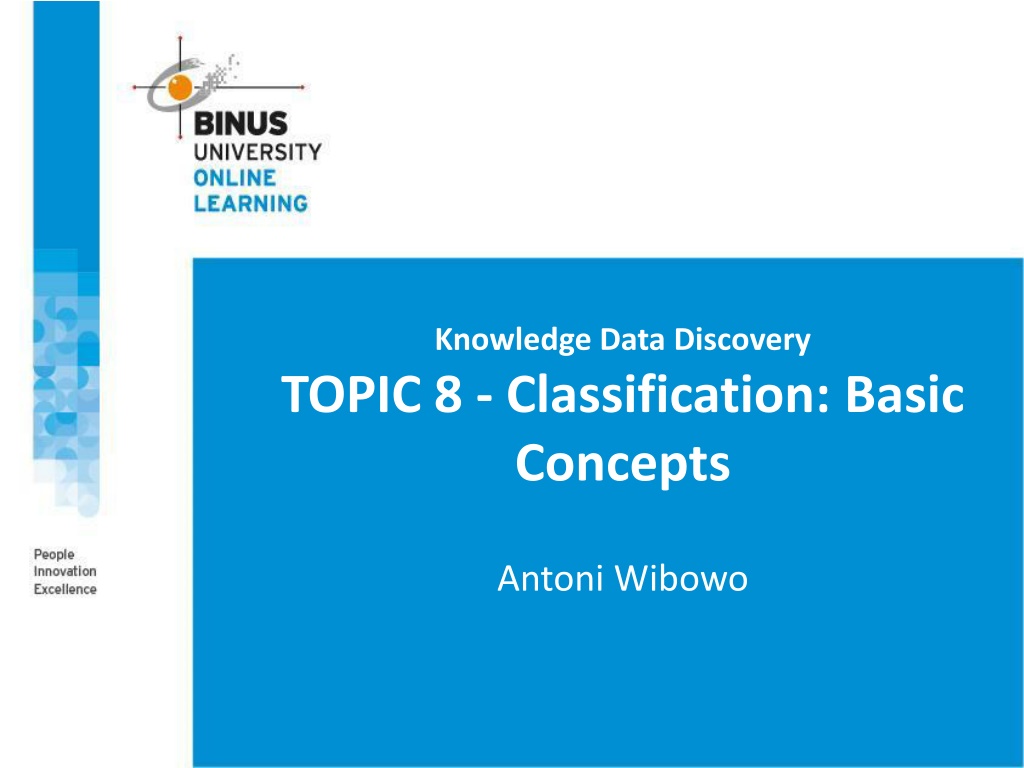
Understanding Classification in Data Mining
Classification in data mining involves assigning objects to predefined classes based on training data. It is a supervised learning task where models map attributes to class labels for accurate predictions. This process is essential in various fields like finance, healthcare, and web categorization, enabling tasks such as fraud detection, medical diagnosis, and web page categorization. The distinction between classification and regression, as well as common examples of classification tasks, are discussed in this overview.
Download Presentation

Please find below an Image/Link to download the presentation.
The content on the website is provided AS IS for your information and personal use only. It may not be sold, licensed, or shared on other websites without obtaining consent from the author. If you encounter any issues during the download, it is possible that the publisher has removed the file from their server.
You are allowed to download the files provided on this website for personal or commercial use, subject to the condition that they are used lawfully. All files are the property of their respective owners.
The content on the website is provided AS IS for your information and personal use only. It may not be sold, licensed, or shared on other websites without obtaining consent from the author.
E N D
Presentation Transcript
Knowledge Data Discovery TOPIC 8 - Classification: Basic Concepts Antoni Wibowo
COURSE OUTLINE 1. WHAT IS CLASSIFICATION? 2. REGRESSION AND CLASSIFICATION 3. GENERAL APPROACH OF CLASSIFICATION TAKS 4. DECISION TREE METHODS 5. RULE-BASED CLASSIFIERS 6. NEAREST NEIGHBOR CLASSIFIER (K-NN)
Note: This slides are based on the additional material provided with the textbook that we use: J. Han, M. Kamber and J. Pei, Data Mining: Concepts and Techniques and P. Tan, M. Steinbach, and V. Kumar "Introduction to Data Mining .
What is Classification? Classification is the task of assigning objects to one of several predefined classes (or categories) on the basis of a training data set containing observations (or instances) whose class membership is known. In the terminology of machine learning, classification is consider an instance of supervised learning problem The training data set is labeled data Each record (known as an instance or example) is characterized by a tuple (x, y), where xis the attribute set and y is a special attribute, designated as the class label (also known as category or target attribute)
What is Classification? Classification is the task of learning a classification model that maps each attribute set x to one of the class labels y. Goal: previously unseen records should be assigned a class as accurately as possible. A test data set is used to determine the accuracy of the model. Usually, the given data set is divided into training sets and test sets, with training set used to build the model and test set used to validate it. Note: If the test set is used to select models, it is called validation (test) set
Classification vs Regression Classification: Predicts categorical class labels Classifies data (constructs a model) based on the training set and the values (class labels) in a classifying attribute and uses it in classifying new data Regression: models continuous-valued functions, i.e., predicts unknown or missing values
Examples of Classification Task Banking: Credit/loan approval Fraud detection: if a transaction is fraudulent Detecting spam email messages based upon the message header and content Medical diagnosis: Predicting tumor cells as benign or malignant based upon the results of MRI scans Biology: Classifying secondary structures of protein as alpha-helix, beta-sheet, or random coil Web page categorization: Categorizing news stories as finance, weather, entertainment, sports, etc
Classification Two-Step Process 1. Model Construction: describing a set of predetermined classes Given a set of labeled data set (as training set) for model construction The model is represented as classification rules, decision trees, or mathematical functions (classifiers) 2. Model Usage: for classifying future or unknown objects Estimate accuracy of the model The known label of test sample is compared with the classified result from the model Accuracy rate is the percentage of test set samples that are correctly classified by the model Test set is independent of training set (otherwise overfitting) If the accuracy is acceptable, use the model to classify new data Note: If the test set is used to select models, it is called validation (test) set 8
Supervised vs. Unsupervised Learning Supervised learning (for classification, regression) Data: lebed data (The class labels of training data is known) Supervision: The training data (observations, measurements, etc.) are accompanied by labels indicating the class of the observations New data is classified based on the training set Unsupervised learning (for clustering) Data: unalebed data (The class labels of training data is unknown) Given a set of measurements, observations, etc. with the aim of establishing the existence of classes or clusters in the data.
Classification Methods Decision Tree-based Methods Rule-based Methods Naive Bayes Classifiers Bayesian Belief Networks Nearest-Neighbor Classifiers (KNN) Artificial Neural Networks (ANN) Support Vector Machines (SVM) Etc...
Decison Tree Methods A decision tree is a flowchart-like structure in which each internal node represents a "test" on an attribute, each branch represents the outcome of the test and each leaf node represents a class label (decision taken after computing all attributes). Ross Quinlan (ID3: 1986), (C4.5: 1993) Breimanetal (CaRT: 1984) from statistics
Decison Tree Methods The tree has three types of nodes: root node that has no incoming edges and zero or more outgoing edges. Internal nodes, each of which has exactly one incoming edge and two or more outgoing edges. Leaf or terminal nodes, each of which has exactly one incoming edge and no outgoing edges. Here, each leaf node is assigned a class label. The paths from root to leaf represents classification rules
Case Study Number of Credit Card Gende r Marital Status Profita bility Age 36 32 38 40 44 56 58 30 28 26 M M M M M F F F F F Yes No Yes S Yes Yes S S Yes Yes 1 3 2 1 0 0 1 2 1 0 Yes No Yes No Yes Yes No Yes No No
Decision Tree Induction: An Example age <=30 <=30 31 40 >40 >40 >40 31 40 <=30 <=30 >40 <=30 31 40 medium 31 40 >40 income student credit_rating buys_computer high no fair high no excellent high no fair medium no fair low yes fair low yes excellent low yes excellent medium no fair low yes fair medium yes fair medium yes excellent no excellent high yes fair medium no excellent no no yes yes yes no yes no yes yes yes yes yes no Training data set: Buys_computer The data set follows an example of Quinlan s ID3 (Playing Tennis) Resulting tree: 18
Rule Extraction from a Decision Tree age? young Mid-age senior student? credit rating? yes excellent fair no yes yes no yes Example: Rule extraction from our buys_computer decision-tree IF age = young AND student = no THEN buys_computer = no IF age = young AND student = yes THEN buys_computer = yes IF age = mid-age IF age = old AND creditrating = excellent THEN buys_computer = no IF age = old AND creditrating = fair THEN buys_computer = yes THEN buys_computer = yes 19
Algorithm for Decision Tree Induction Basic algorithm (a greedy algorithm) Tree is constructed in a top-down recursive divide-and-conquer manner At start, all the training examples are at the root Attributes are categorical (if continuous-valued, they are discretized in advance) Examples are partitioned recursively based on selected attributes Test attributes are selected on the basis of a heuristic or statistical measure (e.g., information gain, gini index, ...) Conditions for stopping partitioning All samples for a given node belong to the same class There are no remaining attributes for further partitioning majority voting is employed for classifying the leaf There are no samples left 20
Brief Review of Entropy m = 2 21
Attribute Selection Measure: Information Gain (ID3/C4.5) Select the attribute with the highest information gain Let pi be the probability that an arbitrary tuple in D belongs to class Ci, estimated by |Ci, D|/|D| Expected information (entropy) needed to classify a tuple in D: log ) ( 1 i = m = ( ) Info D p p 2 i i Information needed (after using A to split D into v partitions) to classify D: | | D v = j ( ) ( ) Info D Info D A j | | D = 1 j Information gained by branching on attribute A Gain(A) = Info(D) Info (D) A 22
Attribute Selection: Information Gain 5 4 = + ( ) ) 3 , 2 ( I ) 0 , 4 ( I Infoage D 14 14 5 + = Class P: buys_computer = yes Class N: buys_computer = no 9 ( log 14 ) 2 , 3 ( I . 0 694 14 5I 9 5 5 ) 3 , 2 ( = I = . 0 = means age <=30 has 5 out of ( ) ) 5 , 9 ( ) log ( ) 940 Info D 14 2 2 14 14 14 14 samples, with 2 yes es and 3 age pi 2 4 3 ni 3 0 2 I(pi, ni) 0,971 0 0,971 <=30 31 40 >40 no s. Hence = = ( ) ( ) ( ) . 0 246 Gain age Info D Info D age age <=30 <=30 31 40 >40 >40 >40 31 40 <=30 <=30 >40 <=30 31 40 medium 31 40 >40 income student credit_rating buys_computer high no fair high no excellent high no fair medium no fair low yes fair low yes excellent low yes excellent medium no fair low yes fair medium yes fair medium yes excellent no excellent high yes fair medium no excellent Similarly, no no yes yes yes no yes no yes yes yes yes yes no = ( ) . 0 = rating 029 Gain income ( ) . 0 151 Gain student = ( _ ) . 0 048 Gain credit 23
Attribute Selection: Information Gain
Computing Information- Gain for Continuous-Valued Attributes Let attribute A be a continuous-valued attribute Must determine the best split point for A Sort the value A in increasing order Typically, the midpoint between each pair of adjacent values is considered as a possible split point (ai+ai+1)/2 is the midpoint between the values of ai and ai+1 The point with the minimum expected information requirement for A is selected as the split-point for A Split: D1 is the set of tuples in D satisfying A split-point, and D2 is the set of tuples in D satisfying A > split-point 25
Gain Ratio for Attribute Selection (C4.5) Information gain measure is biased towards attributes with a large number of values C4.5 (a successor of ID3) uses gain ratio to overcome the problem (normalization to information gain) | ( log | | 1 D j = | | | D D v = j j ( ) ) SplitInfo D 2 A | | D GainRatio(A) = Gain(A)/SplitInfo(A) Ex. gain_ratio(income) = 0.029/1.557 = 0.019 The attribute with the maximum gain ratio is selected as the splitting attribute 26
Gini Index (CART, IBM IntelligentMiner) If a data set D contains examples from n classes, gini index, gini(D) is defined as = j n 2 = ( ) 1 gini D pj 1 where pj is the relative frequency of class j in D If a data set D is split on A into two subsets D1 and D2, the gini index gini(D) is defined as | ) ( D | | | D D = + ( ) ( ) D gini gini 1 2 giniA D D 1 2 | | | | D Reduction in Impurity: = ( ) ( ) ( ) gini A gini D gini D A The attribute provides the smallest ginisplit(D) (or the largest reduction in impurity) is chosen to split the node (need to enumerate all the possible splitting points for each attribute) 27
Computation of Gini Index Ex. D has 9 tuples in buys_computer = yes and 5 in no = D gini 2 2 9 5 = ( ) 1 . 0 459 14 14 Suppose the attribute income partitions D into 10 in D1: {low, medium} and 4 in D2 14 10 4 = + Gini Gini ( ) ( ) ( ) gini D D D { , } 1 2 income low medium 14 Gini{low,high} = 0.458 < Gini{medium,high} = 0.450. Thus, split on the {low,medium} (and {high}) since it has the lowest Gini index 28
All attributes are assumed continuous-valued May need other tools, e.g., clustering, to get the possible split values Can be modified for categorical attributes
Comparing Attribute Selection Measures The three measures, in general, return good results but Information gain: biased towards multivalued attributes Gain ratio: tends to prefer unbalanced splits in which one partition is much smaller than the others Gini index: biased to multivalued attributes has difficulty when # of classes is large tends to favor tests that result in equal-sized partitions and purity in both partitions 30
Other Attribute Selection Measures CHAID: a popular decision tree algorithm, measure based on 2 test for independence C-SEP: performs better than info. gain and gini index in certain cases G-statistic: has a close approximation to 2 distribution MDL (Minimal Description Length) principle (i.e., the simplest solution is preferred): The best tree as the one that requires the fewest # of bits to both (1) encode the tree, and (2) encode the exceptions to the tree Multivariate splits (partition based on multiple variable combinations) CART: finds multivariate splits based on a linear comb. of attrs. Which attribute selection measure is the best? Most give good results, none is significantly superior than others 31
Overfitting and Tree Pruning Overfitting: An induced tree may overfit the training data Too many branches, some may reflect anomalies due to noise or outliers Poor accuracy for unseen samples Two approaches to avoid overfitting Prepruning: Halt tree construction early do not split a node if this would result in the goodness measure falling below a threshold Difficult to choose an appropriate threshold Postpruning: Remove branches from a fully grown tree get a sequence of progressively pruned trees Use a set of data different from the training data to decide which is the best pruned tree 32
Enhancements to Basic Decision Tree Induction Allow for continuous-valued attributes Dynamically define new discrete-valued attributes that partition the continuous attribute value into a discrete set of intervals Handle missing attribute values Assign the most common value of the attribute Assign probability to each of the possible values Attribute construction Create new attributes based on existing ones that are sparsely represented This reduces fragmentation, repetition, and replication 33
Classification in Large Databases Classification a classical problem extensively studied by statisticians and machine learning researchers Scalability: Classifying data sets with millions of examples and hundreds of attributes with reasonable speed Why is decision tree induction popular? relatively faster learning speed (than other classification methods) convertible to simple and easy to understand classification rules can use SQL queries for accessing databases comparable classification accuracy with other methods RainForest (VLDB 98 Gehrke, Ramakrishnan & Ganti) Builds an AVC-list (attribute, value, class label) 34
Scalability Framework for RainForest Separates the scalability aspects from the criteria that determine the quality of the tree Builds an AVC-list: AVC (Attribute, Value, Class_label) AVC-set (of an attribute X ) Projection of training dataset onto the attribute X and class label where counts of individual class label are aggregated AVC-group (of a node n ) Set of AVC-sets of all predictor attributes at the node n 35
Rainforest: Training Set and Its AVC Sets AVC-set on Age AVC-set on income income Buy_Computer Buy_Compute Training Examples Age r yes no income studentcredit_rating high no high no 31 40 high >40 medium >40 low >40 low 31 40 low <=30 medium <=30 low >40 medium <=30 medium 31 40 medium 31 40 high >40 medium age buys_computer no excellent fair fair fair excellent excellent fair fair fair excellent excellent fair excellent yes no high 2 2 <=30 <=30 fair <=30 2 3 medium 4 2 no yes yes yes no yes no yes yes yes yes yes no 31..4 0 no no yes yes yes no yes yes yes no yes no low 3 1 4 0 >40 3 2 AVC-set on Student AVC-set on credit_rating Buy_Computer student Buy_Computer Credit rating yes no yes no fair 6 2 yes 6 1 excellent 3 3 no 3 4 36
BOAT (Bootstrapped Optimistic Algorithm for Tree Construction) Use a statistical technique called bootstrapping to create several smaller samples (subsets), each fits in memory Each subset is used to create a tree, resulting in several trees These trees are examined and used to construct a new tree T It turns out thatT is very close to the tree that would be generated using the whole data set together Adv: requires only two scans of DB, an incremental alg. 37
Presentation of Classification Results 38 March 17, 2025 Data Mining: Concepts and Techniques
Visualization of a Decision Tree in SGI/MineSet 3.0 39 March 17, 2025 Data Mining: Concepts and Techniques
Using IF-THEN Rules for Classification Represent the knowledge in the form of IF-THEN rules R: IF age = youth AND student = yes THEN buys_computer = yes Rule antecedent/precondition vs. rule consequent Assessment of a rule: coverage and accuracy ncovers = # of tuples covered by R ncorrect = # of tuples correctly classified by R coverage(R) = ncovers /|D| /* D: training data set */ accuracy(R) = ncorrect / ncovers If more than one rule are triggered, need conflict resolution Size ordering: assign the highest priority to the triggering rules that has the toughest requirement (i.e., with the most attribute tests) Class-based ordering: decreasing order of prevalence or misclassification cost per class Rule-based ordering (decision list): rules are organized into one long priority list, according to some measure of rule quality or by experts 41
Rule Extraction from a Decision Tree age? Rules are easier to understand than large trees One rule is created for each path from the root to a leaf Each attribute-value pair along a path forms a conjunction: the leaf holds the class prediction Rules are mutually exclusive and exhaustive <=30 31..40 >40 student? credit rating? yes excellent fair n o yes yes no yes Example: Rule extraction from our buys_computer decision- tree IF age = young AND student = no THEN buys_computer = no IF age = young AND student = yes THEN buys_computer = yes IF age = mid-age THEN buys_computer = yes IF age = old AND credit_rating = excellent THEN buys_computer = no IF age = old AND credit_rating = fair THEN buys_computer = yes 42
Rule Induction: Sequential Covering Method Sequential covering algorithm: Extracts rules directly from training data Typical sequential covering algorithms: FOIL, AQ, CN2, RIPPER Rules are learned sequentially, each for a given class Ci will cover many tuples of Ci but none (or few) of the tuples of other classes Steps: Rules are learned one at a time Each time a rule is learned, the tuples covered by the rules are removed Repeat the process on the remaining tuples until termination condition, e.g., when no more training examples or when the quality of a rule returned is below a user-specified threshold Comp. w. decision-tree induction: learning a set of rules simultaneously 43
Sequential Covering Algorithm while (enough target tuples left) generate a rule remove positive target tuples satisfying this rule Examples covered by Rule 2 Examples covered by Rule 1 Examples covered by Rule 3 Positive examples 44
Rule Generation To generate a rule while(true) find the best predicate p if foil-gain(p) > threshold then add p to current rule else break A3=1&&A1=2 A3=1&&A1=2 &&A8=5 A3=1 Positive examples Negative examples 45
How to Learn-One-Rule? Start with the most general rule possible: condition = empty Adding new attributes by adopting a greedy depth-first strategy Picks the one that most improves the rule quality Rule-Quality measures: consider both coverage and accuracy Foil-gain (in FOIL & RIPPER): assesses info_gain by extending condition ' pos + pos + = (log _ ' log ) FOIL Gain pos 2 2 ' ' pos neg pos neg favors rules that have high accuracy and cover many positive tuples Rule pruning based on an independent set of test tuples R Prune FOIL = ) ( _ pos neg + pos neg Pos/neg are # of positive/negative tuples covered by R. If FOIL_Prune is higher for the pruned version of R, prune R 46
Lazy Learning vs Eager Learning Lazy vs. eager learning Lazy learning (e.g., instance-based learning): Simply stores training data (or only minor processing) and waits until it is given a test tuple Eager learning (the above discussed methods): Given a set of training tuples, constructs a classification model before receiving new (e.g., test) data to classify Lazy: less time in training but more time in predicting Accuracy Lazy method effectively uses a richer hypothesis space since it uses many local linear functions to form an implicit global approximation to the target function Eager: must commit to a single hypothesis that covers the entire instance space 48
Lazy Learner: Instance- Based Methods Instance-based learning: Store training examples and delay the processing ( lazy evaluation ) until a new instance must be classified Typical approaches k-nearest neighbor approach Instances represented as points in a Euclidean space. Locally weighted regression Constructs local approximation Case-based reasoning Uses symbolic representations and knowledge-based inference 49
Nearest Neighbor Classifiers Basic idea: If it walks like a duck, quacks like a duck, then it s probably a duck Compute Distance Test Record Choose k of the nearest records Training Records





